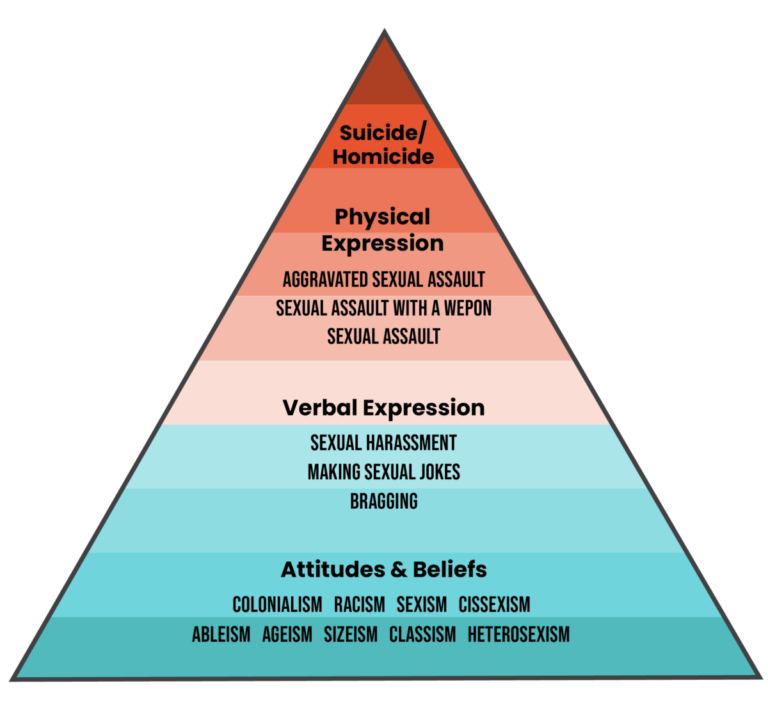Sexual violence is not an isolated event that happens to a few individuals in a random, unpredictable way. It is a normalized pattern of behavior that is upheld by systems of oppression.
Sexual violence is not about sex, it is about power and control. Sexual violence is the result of power imbalances that stem from attitudes and beliefs about those who are valued in our society and those who are not.
Acts of sexual violence are justified and normalized by a deeply held base of oppressive attitudes and beliefs. When these attitudes and beliefs are reinforced by friends and family, our social norms, and the media we consume, they have the potential to influence our behaviour.

To understand sexual violence, we must first examine the attitudes and beliefs that we hold about other people.
These attitudes and beliefs are informed by systems of oppression.
- Systems of oppression refer to larger forces and structures operating in society that create inequalities and reinforce exclusion. These systems are built around societal norms and are constructed by the dominant group(s) in society.
- Notice how systems of oppression such as sexism, colonialism, racism, ableism, and others are at the foundation of the pyramid. Sexual violence is upheld by various systems of oppression. Those who live at the intersections of these oppressive systems experience the highest rates of sexual violence.
These systems can lead to the formation of oppressive attitudes and beliefs that reflect those who are valued in our society and those who are not. These same beliefs are often used to discriminate against or oppress marginalized people.
Sexual violence is a crime of power and control that stems from oppressive attitudes and beliefs.
Oppressive attitudes and beliefs allow for the justification of acts that belittle, demean, objectify, and dehumanize certain groups of people.
These oppressive attitudes and beliefs are commonly validated, normalized, and minimized in the shows, movies, music, and advertisements that we consume. Images of women, girls, transgender people, racialized people, Indigenous people, and others being objectified, dehumanized, and abused are all around us. Consequently, these groups of people are less likely to be treated as equal humans with feelings and rights.
As individuals cultivate these beliefs through exposure and repeated reinforcement, their conscious – or potentially unconscious – belief that certain types of people are not deserving of the same kindness, respect, dignity, and autonomy that they are given is strengthened. This creates the dynamics of a power imbalance.
This is the root cause of sexual violence, which is reflected as the foundation of the pyramid.
Attitudes and beliefs inform action.
When oppressive attitudes and beliefs are justified and normalized, people may choose to verbally and/or physically express themselves through violence in the form of sexual harassment, abuse, or assault.
Sexual violence is not about sex, it is about a desire to exert power over another person through force or sexual coercion.
Those who hold oppressive attitudes and beliefs may choose to verbally express their feelings of entitlement and superiority. This may look like telling sexist jokes, making stereotypical, degrading, or demeaning comments, and even sexually harassing others. That being said, it is important to acknowledge that this does not mean everyone who makes a sexist joke or believes an outdated stereotype will go on to commit sexual violence.
While most people will never progress past this point, others may escalate to physical expression and choose to commit acts of sexual abuse or assault.
Those who use abusive behaviours are fully responsible for their actions. Those who are harmed by sexual violence are never to blame. Unfortunately, sexual violence has been so normalized and minimized in our society that those who use abusive behaviors may not even recognize their actions as abusive and therefore, may not feel responsible for the harm they have caused.
The pyramid is also upheld by the attitudes, beliefs, and actions of many, including the countless people who would never commit an act of sexual violence. In this way, we all in conscious and unconscious ways, contribute to the creation of social environments where abusive behaviors are normalized, excusable, and tacitly condoned.
How can this information be used to end sexual violence?
We all have the ability to individually and collectively influence each level of this pyramid in a positive way. Check out the Ending Sexual Violence page for more information.
Interested in learning more about this?
Check out our upcoming workshops First Responder to Sexual Assault and Abuse Training.